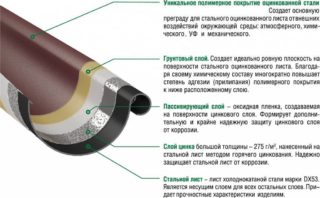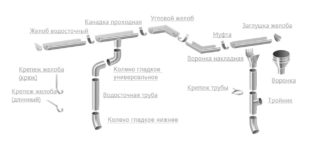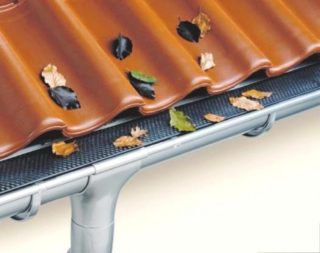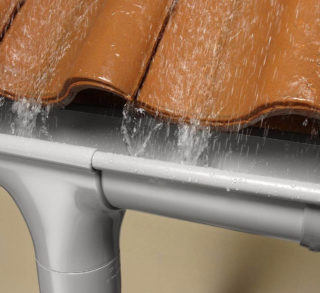The popularity of galvanized steel drainage systems was at their peak in the 80s-90s of the 20th century. The construction industry is not standing still, and now the thin steel sheet has improved technical characteristics. As a result, the demand for galvanized steel is increasing again. Thin steel drainage systems are installed in both private and commercial buildings.
Technical characteristics of galvanized gutter system

Structurally, all communication has the form of separate elements connected in series with each other - gutters, funnels, vertical drainpipes. Additional fixation is provided by self-tapping screws, brackets, clamps.
Galvanized steel has the following technical characteristics:
- operation of the material in the temperature range from -60 to +135 degrees;
- fire safety;
- inertness to aggressive environments;
- strength and resistance to mechanical stress of moderate intensity;
- low weight of products;
- zinc coating thickness - from 10 to 60 microns.
The quality of the finished steel sheet always complies with GOST 16523-89.
Installation features

There are several ways to mount a galvanized gutter, depending on the general structure of the building and the design idea. Experts identify the following drainage device methods:
- External. All elements are placed outside the box at home. Horizontal gutters are fixed under the roof slopes, while vertical pipes are visible to the human eye. This method is relevant for regions where there is not a large amount of snowfall and prolonged subzero temperatures. Otherwise, frost may form in the gutters.
- Interior. Vertical pipes are placed behind the external curtain wall. This is done to hide communication from prying eyes and thereby preserve the exterior of the house, as well as to protect galvanized elements from winter freezing.
Sometimes experts resort to a combined method of installing a steel drainage system. Vertical pipes are laid behind the hinged facade, and their fastening is made outside. The main advantages of this method are simple assembly of the structure, good protection of pipes from freezing.
Mount the drain in the following sequence:
- Special brackets for the gutters are fixed to the outer frontal board or rafter legs of the roof frame. They are positioned in 50-70 cm increments, depending on the capacity of the tray. The larger it is, the smaller the distance between the hooks should be.
- When fixing the brackets, observe the slope towards the funnel. It is made at the rate of 0.5-1 cm for each running meter of the gutter. The slope is controlled with a control cord stretched from the first to the last bracket. In this case, each hook ultimately must hold the tray under the roof so that the distance from the slope to the gutter is no more than 15 cm.
- After mounting the hooks, a receiving funnel is installed.
- The receiving trays are fixed by joining them together. The surface area of the gutter should go 1/3 under the roof slope.
- Install a vertical drainpipe. If it is necessary to bypass the protrusions of the building frame, use special transitional elbows.
- The pipe is additionally fixed to the box of the house with clamps with a step of 80-100 cm.
The finished system must be checked for throughput and tightness.
Operating and maintenance principles

When operating drainage from thin steel, it must be remembered that the main enemy of metal, namely its zinc top layer, is abrasives and sharp objects (branches, stones). They move with water flows, clog gutters / pipes and damage their inner walls. As a result, the zinc layer cracks and the steel corrodes. To protect the system, it is advisable to adhere to these recommendations:
- Initially, install protective grilles on the gutters. They can be perforated, slotted, as well as made of light polymer or the same steel.
- Once every six months, it is worth cleaning the system of small debris. It is advisable to remove branches, leaves with soft brushes, but in no case with sticks or sharp objects.
- Once a year, or at the beginning of each season, the gutter should be flushed to ensure that the funnels or vertical pipes are not clogged.
If one of the elements is out of order (scratched, bent), it is better to replace it immediately. Otherwise, the functionality of the entire drainage system will be several times lower than expected.
Advantages and disadvantages of a galvanized gutter system

The popularity of galvanized steel gutters is due to the following advantages of the material and the communication itself:
- Light weight of elements. All components can be transported by personal light vehicles. Installation of drainage from steel can be done independently.
- Inertness to ultraviolet light. Unlike polymer painted elements, zinc coating does not fade, does not change its shade. An exception is made for those components that were additionally coated with colored paints before being sold.
- Resistant to moisture. Due to the protective zinc coating, thin steel does not rust for 15 years or more.
- Inertness to aggressive impurities in water. The decision to galvanize steel made it possible to protect it from the negative effects of acids, alkalis, ammonia, etc.
- Maintains performance over a wide temperature range. Zinc coated steel is not prone to expansion or other deformation under the influence of temperature extremes. This means that the tightness of the system remains complete.
- Long service life. A properly installed system can operate for up to 20 years or more.
- Affordable prices for drainage elements.
The only drawback of galvanized steel is its low level of sound insulation. The residents of the house will hear the noise of rain and hail in full.
Product prices
The prices of galvanized steel drainage systems include all the necessary elements for the installation of a full-fledged drainage system. Average cost of components:
- horizontal gutters - 130-250 rubles / running meter;
- gutter angle - 300 rubles. and higher;
- drain vertical pipe - 220-400 rubles / running meter;
- funnel - from 450 rubles;
- transitional knee - from 330 rubles;
- bracket - 70-200 rubles;
- clamps - 70-90 rubles.
The price of each metal element varies slightly depending on the thickness of the steel and the applied galvanized layer. When purchasing components, it is important to pay attention to the accuracy of the geometry of the products. Only in this case, the drainage system will be assembled without flaws, and the trays and pipes will become end-to-end without hassle.








